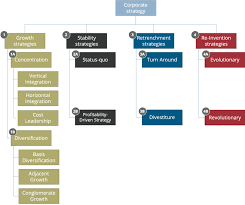The importance of the company’s strategy in all its forms and types is wide
There are a few notable differences between corporate strategy and business strategy. The company’s strategic vision is extensive, and includes various units and products, their relationship, and overall brand reputation.

On the contrary, business strategy is concerned with a single business unit and is limited to a particular product or market. Business strategy aligns with corporate strategy criteria.
The importance of corporate strategy

The corporate strategy defines the ultimate goal that the company must achieve. Finds applicability in the environment in which the company operates in multiple business areas. In such a situation, different business units require a specific strategy.
Managers must ensure that these strategies are in line with the company’s overall strategy. Thus, MNCs (multinational corporations) have common strategic divisions, which are not commonly found in start-ups or medium-sized organizations.
main reasons
- The strategy focuses on the entire company rather than looking at each business unit.
- It helps identify current and potential problems that hinder growth.
- Helps prevent plans that will not be healthy for the company’s growth
- Serves as a base for developing individual business unit strategies
- Assists in developing contingency plans for implementation when needed.
Types of corporate strategy

1. Stability strategy:
The primary goal of any business is to grow and earn profits. While making profits, their goal is to stabilize their profits. Therefore, stability strategy studies maintain growth, profits and the current market position.
A direct example of a stability strategy is when an organization chooses to offer the same product to customers rather than offering a new one. This usually follows when the organization is satisfied with its current position and market share. Under such circumstances, organizations do not need to expend any additional resources or expertise.
2. Expansion strategy
Companies use various measures to stabilize their profits. Their goal is to achieve more prosperity as their business expands. The organization follows an expansion strategy when it aspires to grow compared to its current standards. Companies are improving their operations to target more customers.
Companies with ambition and ambition follow this strategy. As part of this, they are willing to take risks and grow. Some of them may be improved market share, higher profits and reputation. The reason for implementing the expansion strategy may differ from one company to another.
3. Reduction strategy
Companies set policies to determine what suits their interests. During crises, companies cut a few redundant activities to ensure the financial stability and profits of the organizations.
An outlay strategy is a way to cut out all unprofitable products and services for your business to achieve financial stability. This can often result in the sale of assets or a reduction in staff strength.
4. Combination strategy
Compound strategy is the simultaneous use of stabilization, expansion, and reduction. An organization can use it for different business simultaneously or for the same business in other cases to enhance business efficiency.
How do you choose the right corporate strategy?
While defining the right strategy for your organization, study various industries and assess their performance by conducting a SWOT (Strengths, Weaknesses, Opportunities, and Threats) analysis.
1. Strengths : Identify areas in your organization that currently excel, such as your brand’s reputation, and maximize its benefits
2. Weaknesses: Here are the areas in which companies need to improve their performance. For example, it may be low brand reputation, insufficient capital, supply chain, or few debt hurdles.
3. Opportunities: Many opportunities are waiting to be seized on the growth path. Suppose a new skill in the market has excellent potential for success. You can make it a part of your organization by training employees to develop skills and experience.
4. Threats: Threats can harm an organization. For example, an increase in the cost of raw materials may reduce profits or cause the organization to increase MRP.





















